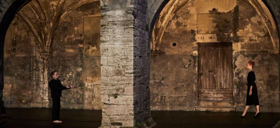Review: AVIGNON THEATRE FESTIVAL Presents CANZONE PER ORNELLA By RAIMUND HOGHE

The atmosphere couldn't be better. In the Avignon Theatre Festival's Cloître des Célestins there are stars in the sky, the smell of Italian food wafts from a restaurant in the nearby square, and a nostalgia-laden playlist of torch songs, jazz standards, and classical music fills the gothic cloister. Raimund Hoghe has set the mood perfectly and his resulting Canzone Per Ornella shimmers in its glow. This work, performed primarily by Hoghe and collaborator Ornella Balestra, is a moving elegy to dance, life, and human dignity.
Hoghe begins the piece alone, wandering around the space. With him he carries a small tank of water with a boat within it. He then lies face down, placing his hand in the tank like a high art rendition of the adolescent warm water prank. Some images later he stands as Orff's "O Fortuna" blasts. His usual ironic detachment is replaced with a look of awe. He sees something we don't. Now framed within the central archway of the upstage corridor, his fragility becomes tangible.
Walking with an effervescent dignity, Ornella traverses the cloister's gothic arched arcade. Ornella, a former soloist with Maurice Bejart, is a remarkable vessel for Hoghe's sedate minimalism. Later, in a riveting break from his austerity she performs Odette in black high heels. The performance occurs upstage left within the frame of one of the cloister's archway. However, where this architecture made Hoghe's usually concealed frailness tangible, she seemed to be designed from the cloister's blue prints. Her arms arch up in sensual waves. In this moment she is the embodiment of the archetypal dancer discipline.
When the two dancers share images, the difference in both form and execution between them is remarkable. Where Hoghe performs methodically with a stiff upper lip, Ornella moves with a smoldering melancholy and matured discipline. In one scene Ornella directs Hoghe through a simple port de bras and plié exercise. She towers over the man who unselfconsciously follows her instructions. Most times when ballet process is presented on a modernist's stage, the framework is highly critical. My mind turns to Sasha Waltz's Kreature and the demands of "Stop crying!" and then, "Stop breathing!" Balestra's ballet instruction is a rebuke of this criticism. Her instruction is a vehicle for tenderness. It is a moment of enchanting intimacy. Hoghe too has a chance to instruct as he brings Balestra stage left and, hands on either side of her head, directs her gaze slowly left and right as she silently cries beneath a pair of sunglasses. Lighting by Hoghe and Amaury Seval is minimal and delicate. Dancer Luca Giacomo Schulte makes brief appearances on stage to, at times, hold a prop and then later share in a slow dance with Balestra.
At the end of the performance Hoghe gathers all props and arranges them in a row in the center. Balestra discards her heels and places them center stage. Hoghe then proceeds to cover these items in gold foil. Placing the tank on the stage floor, he frees the hitherto forgotten boat from its tank, and places it in the center of this sea of gold. Balestra has offered her part of the collaboration; she gives Hoghe a body with the dancer's wide vocabulary. Hoghe too has done his part; he has given her a vehicle to use this body to express sublime emotion. What's more important, the exchange is quite evidently an edifice to the power of mutual respect. Canzone Per Ornella is a love song for this mature and rapturous collaboration.
Photo Credit: Christophe Raynaud de LageReader Reviews
Videos

